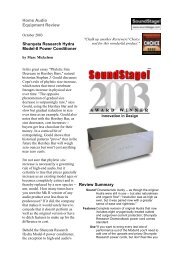Download Model 5 brochure
Download Model 5 brochure
Download Model 5 brochure
You also want an ePaper? Increase the reach of your titles
YUMPU automatically turns print PDFs into web optimized ePapers that Google loves.
sequential amplifier stages are used. Most modern<br />
high performance amplifiers use as many as seven<br />
cascaded stages. In addition the input signal does<br />
not only have to pass through several serial amplifier<br />
stages but most of the amplifiers use several<br />
power transistors in parallel to achieve a higher<br />
power output. In some “monster” amplifier designs<br />
up to 20 power transistors are switched in parallel.<br />
Serial and parallel signal processing have two<br />
major disadvantages. First of all any transistor –<br />
even highest-grade versions produce distortions.<br />
The more stages are used, the higher the distortions<br />
of the circuitry become. And theses “distortions”<br />
do not only add to each other, but multiply together<br />
as well. This is because every stage amplifies the<br />
distortions of the previous stage and modulates its<br />
own distortions on top of it!<br />
The second problem refers to the speed in which<br />
the feedback readjusts the problems at the output.<br />
The more stages an amplifier has, the slower the<br />
“forward” processing of the signal is, and the bigger<br />
the lateral off-set between the input and the<br />
output of the amplifier becomes. In practice this is<br />
called “slow forward amplification”. In the laboratory,<br />
distortion occurring during the amplification<br />
of the signal can be eliminated with a high feedback,<br />
but these corrections only become active due<br />
to the slow forward amplification with a subsequent<br />
time delay. This is to say that the corrections do<br />
happen with inertia and thus probably at a moment<br />
in which the original distortion has already disappeared.<br />
The feedback thus generates an inevitable<br />
new distortion, which is again amplified by the<br />
forward processing and is again corrected by the<br />
feedback etc. etc. The delay between the start and<br />
the elimination of the problem permanently generates<br />
new distortions. The amplifier gets into a stage of<br />
permanent oscillation and has more work fixing<br />
itself generated problems than with processing the<br />
original signal. Fortunately these self-produced<br />
distortions are mostly of linear nature. This is to say<br />
that the amplifier circuit corrects the same distortion<br />
all over again, regardless of the music signal. The<br />
described time delay when correcting these self<br />
produced linear distortions, in practical operation<br />
is, subjectively not so critical.<br />
Contrary to above, this problem is much more serious<br />
with a speaker connected, e.g. a varying<br />
complex load. Any speaker system is an unknown,<br />
variable disturbance which is continously inducing<br />
interferences into the amplifier. These electro-magnetic-forces<br />
are induced by electrical currents of the<br />
speaker drivers and these are fed back to the amplifier<br />
as variable error voltages. The feedback detects<br />
these error voltages and tries to eliminate<br />
them. As these electro-magnetic-forces permanently<br />
change with frequency and level of the music, the<br />
correction occurs with a time delay, so the correction<br />
will logically always be too late. For an experienced<br />
listener it is relatively easy to distinguish between<br />
the relatively harmless self-generated amplifier<br />
distortions and feedback distortions induced by the<br />
speaker. Mostly in operation this problem shows up<br />
as a “slow”, sometimes “hard” midrange/treble<br />
response and a reduced resolution of the system.<br />
Furthermore the delay of the feedback will cause a<br />
permanent shifting of the phase of the signal, which<br />
shows up as harmonic distortions. This results in a<br />
“specific” tonality of the amplifier with reduced<br />
sound staging and naturalness of the sound.<br />
THE AVANTGARDE PHILOSOPHY<br />
Avantgarde Acoustic loudspeakers are known to<br />
react very quickly to any variation of the music<br />
signal and to transform these into audible sound.<br />
“With our speakers we use the horn technology to<br />
make the forward acceleration and transient response<br />
as fast as possible. What goes in, should<br />
come out,” describes Matthias Ruff. Different to<br />
most manufacturers who optimise the decay time of<br />
their speakers (waterfall diagram) the company<br />
from Lautertal regard the fast forward signal processing<br />
as the main advantage of their speaker<br />
designs. “Who cares about the second distortion, if<br />
the first distortion has not even been detected. Most<br />
speakers are purposely made slow and inert, only<br />
to make the waterfall graphs look good in reviews.<br />
It is so obvious: the less I let pass through from the<br />
front, the better it looks from behind. But this doesn’t<br />
mean that you have a good speaker. It is like reducing<br />
the maximum speed of car drastically only to<br />
improve the breaking distance,” explains the<br />
Avantgarde designer furiously. And with multi-stage<br />
amplifiers having high forward gain and strong<br />
feedback Matthias Ruff is seeing the same problems.<br />
“In the HGHF-principle you purposely put<br />
up with errors during the forward amplification,<br />
because later at the end you can flatten everything<br />
with a high feedback”. In other words these designers<br />
do not even try to prevent distortion in the<br />
early gain stages, but count on heavy reprocessing<br />
of the signal at the end. “If I already falsify the signal<br />
at the front end, I can later correct as much as I<br />
want, the information simply gets irretrievably lost”.


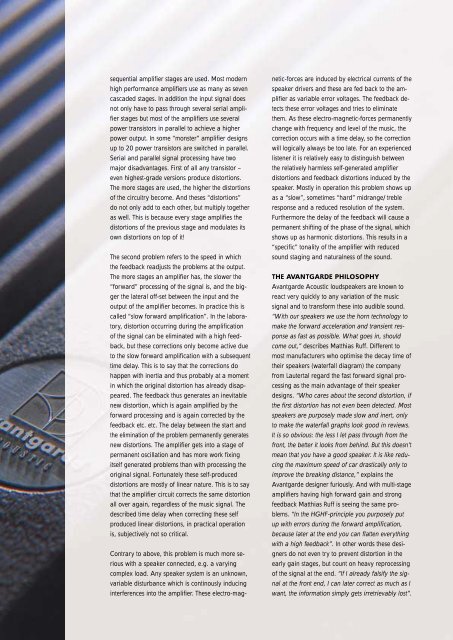
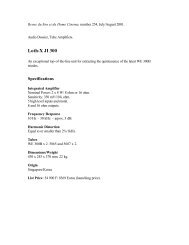


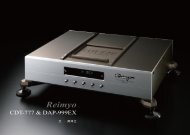

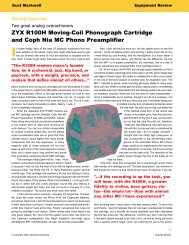

![DAP-999 EX Limited [pdf] - Audio Note Singapore](https://img.yumpu.com/27191044/1/190x253/dap-999-ex-limited-pdf-audio-note-singapore.jpg?quality=85)

![Harmonix CS-120 Improved-Version [pdf]](https://img.yumpu.com/24411255/1/184x260/harmonix-cs-120-improved-version-pdf.jpg?quality=85)
